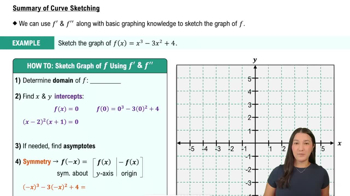If x¹/³ + y¹/³ = 4, find d²y/dx² at the point (8, 8).
Table of contents
- 0. Functions7h 54m
- Introduction to Functions16m
- Piecewise Functions10m
- Properties of Functions9m
- Common Functions1h 8m
- Transformations5m
- Combining Functions27m
- Exponent rules32m
- Exponential Functions28m
- Logarithmic Functions24m
- Properties of Logarithms36m
- Exponential & Logarithmic Equations35m
- Introduction to Trigonometric Functions38m
- Graphs of Trigonometric Functions44m
- Trigonometric Identities47m
- Inverse Trigonometric Functions48m
- 1. Limits and Continuity2h 2m
- 2. Intro to Derivatives1h 33m
- 3. Techniques of Differentiation3h 18m
- 4. Applications of Derivatives2h 38m
- 5. Graphical Applications of Derivatives6h 2m
- 6. Derivatives of Inverse, Exponential, & Logarithmic Functions2h 37m
- 7. Antiderivatives & Indefinite Integrals1h 26m
- 8. Definite Integrals4h 44m
- 9. Graphical Applications of Integrals2h 27m
- 10. Physics Applications of Integrals 3h 16m
- 11. Integrals of Inverse, Exponential, & Logarithmic Functions2h 31m
- 12. Techniques of Integration7h 41m
- 13. Intro to Differential Equations2h 55m
- 14. Sequences & Series5h 36m
- 15. Power Series2h 19m
- 16. Parametric Equations & Polar Coordinates7h 58m
4. Applications of Derivatives
Implicit Differentiation
Problem 3.89
Textbook Question
Find the slope of the curve x³y³ + y² = x + y at the points (1, 1) and (1, -1).
 Verified step by step guidance
Verified step by step guidance1
To find the slope of the curve at a given point, we need to find the derivative of the curve with respect to x. The curve is given by the equation: x³y³ + y² = x + y.
Use implicit differentiation to differentiate both sides of the equation with respect to x. Remember that y is a function of x, so when differentiating terms involving y, apply the chain rule.
Differentiate the left side: For x³y³, use the product rule: d/dx(x³y³) = x³ * d/dx(y³) + y³ * d/dx(x³). For y², use the chain rule: d/dx(y²) = 2y * dy/dx.
Differentiate the right side: d/dx(x) = 1 and d/dx(y) = dy/dx.
After differentiating, solve the resulting equation for dy/dx to find the expression for the slope of the curve. Substitute the points (1, 1) and (1, -1) into this expression to find the slope at each point.
 Verified video answer for a similar problem:
Verified video answer for a similar problem:This video solution was recommended by our tutors as helpful for the problem above
Video duration:
3mPlay a video:
Was this helpful?
Key Concepts
Here are the essential concepts you must grasp in order to answer the question correctly.
Implicit Differentiation
Implicit differentiation is a technique used to find the derivative of a function defined implicitly by an equation involving both x and y. Instead of solving for y explicitly, we differentiate both sides of the equation with respect to x, treating y as a function of x. This allows us to find dy/dx, which represents the slope of the curve at any point.
Recommended video:

Finding The Implicit Derivative
Slope of a Curve
The slope of a curve at a given point is defined as the rate of change of the y-coordinate with respect to the x-coordinate at that point. Mathematically, it is represented by the derivative of the function at that point. For curves defined by implicit equations, the slope can be found using the derivative obtained through implicit differentiation.
Recommended video:

Summary of Curve Sketching
Evaluating Derivatives at Specific Points
Once the derivative (dy/dx) is determined, evaluating it at specific points involves substituting the coordinates of those points into the derivative expression. This gives the slope of the curve at those specific locations. In this case, we will substitute the points (1, 1) and (1, -1) into the derived expression to find the respective slopes.
Recommended video:

Critical Points

 5:14m
5:14mWatch next
Master Finding The Implicit Derivative with a bite sized video explanation from Patrick
Start learningRelated Videos
Related Practice
Textbook Question
